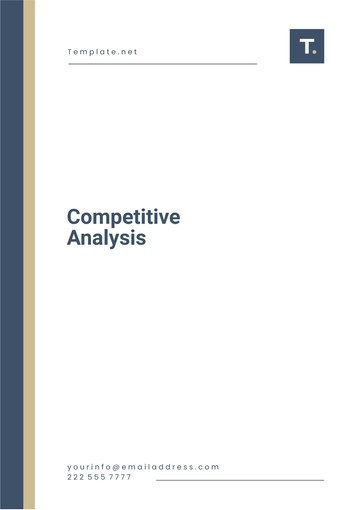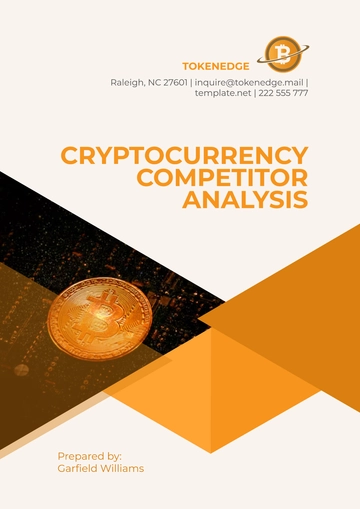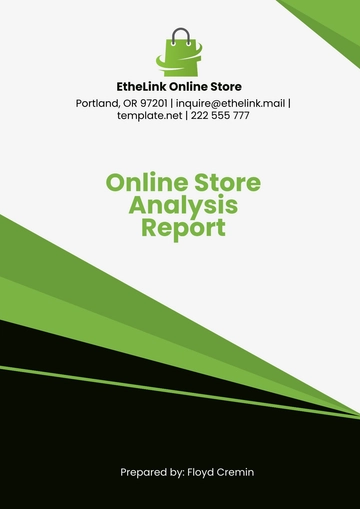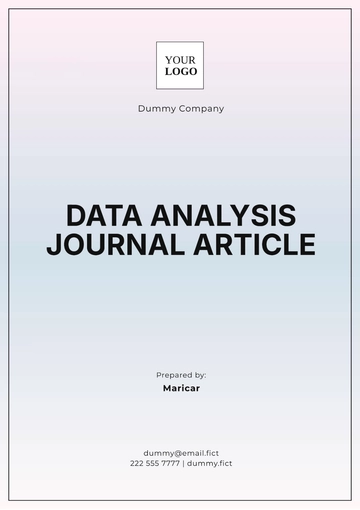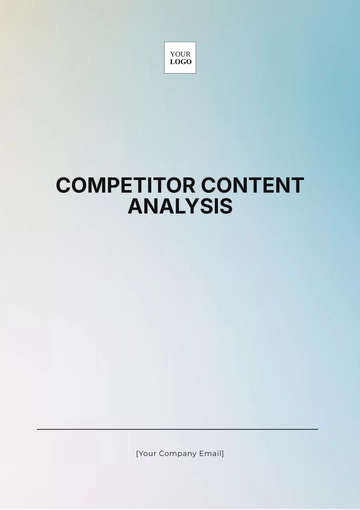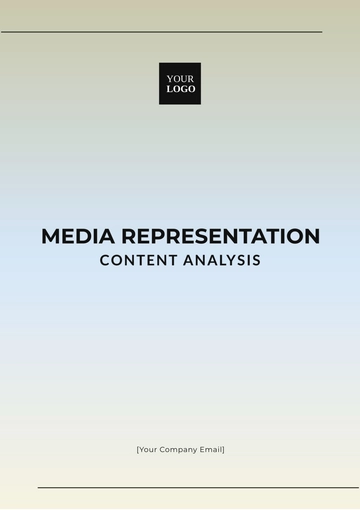Free Travel Agency Analysis Report

I. Executive Summary
This report offers a comprehensive analysis of [YOUR COMPANY NAME]'s current standing in the travel industry, identifying major trends, competitive positioning, and customer behavior patterns that influence strategic decisions. Key findings include a 10% year-over-year growth in market share, attributed largely to enhanced digital marketing strategies and robust customer service improvements. However, areas such as mobile platform engagement and international market penetration represent significant opportunities for further growth.
Key performance indicators suggest:
A 15% increase in customer retention rates following the implementation of personalized travel packages.
Competitive analysis shows [YOUR COMPANY NAME] holding a solid 3rd position in market share, trailing by only 5% from the market leader.
The following actionable insights have been prioritized:
Expand digital presence to enhance customer engagement across mobile platforms.
Explore strategic partnerships to increase international market reach.
Invest in emerging technologies like AI to personalize travel experiences further.
II. Industry Overview
The travel industry is currently experiencing a phase of rapid transformation, influenced by technological advancements and shifts in consumer preferences. Economic indicators suggest a robust recovery with a projected 7% growth in global travel spending over the next year. [YOUR COMPANY NAME] needs to align its strategies with these evolving dynamics to maintain and enhance its competitive edge.
Sector-Specific Trends:
Leisure Travel: Rising by approximately 12% annually, driven by an increase in experiential travel demand.
Business Travel: Shows moderate growth; however, the adoption of virtual meeting technologies poses challenges to traditional business travel models.
Luxury Travel: Continues to expand, with consumers showing greater interest in bespoke and exclusive experiences.
Recent global events, such as the ongoing recovery from pandemic disruptions, have shifted travel patterns significantly, emphasizing the need for flexible and adaptive business strategies. Additionally, environmental sustainability has become a crucial factor, as more consumers prefer eco-friendly travel options.
III. Competitive Analysis
To maintain a leading edge, understanding the competitive landscape is crucial. This section offers a detailed breakdown of major competitors, showcasing how [YOUR COMPANY NAME] stacks up against them in various performance metrics.
Key Competitors:
TravelCo: Holds the largest market share but has lower customer satisfaction due to weak after-sales support.
JetSet Ventures: Noted for innovative package deals but struggles with high operational costs.
Competitor Comparison Table:
Competitor | Market Share | Customer Satisfaction | Innovative Offerings |
|---|---|---|---|
[YOUR COMPANY NAME] | 18% | 85% | High |
TravelCo | 23% | 75% | Medium |
JetSet Ventures | 15% | 80% | High |
A SWOT analysis reveals:
Strengths: Strong customer loyalty and innovative travel packages.
Weaknesses: Limited presence in non-English speaking regions.
Opportunities: Expansion into emerging markets and enhancement of digital services.
Threats: Increasing competition from new, tech-driven travel firms.
IV. Customer Insights
Understanding customer preferences is pivotal for tailoring [YOUR COMPANY NAME]'s offerings. This section explores key customer segments and identifies trends in purchasing behaviors and preferences.
Customer Segmentation:
Segment A (Young Professionals): Prefers adventurous and social travel experiences. High demand for seamless digital services.
Segment B (Retirees): Values comfort, luxury, and high-quality service. Interested in extended, leisurely travel options.
Insights from Customer Data:
Surveys indicate a 90% satisfaction rate in personalized travel planning.
Feedback mechanisms highlight a request for more sustainable travel options and increased transparency in pricing.
Strategies for Enhancement:
Implement AI-driven tools to provide real-time, personalized travel suggestions.
Develop eco-friendly travel packages to attract environmentally conscious consumers.
Revamp the loyalty program to include tiered rewards based on customer feedback and travel frequency.
V. Strategic Recommendations
Based on the in-depth analysis conducted in the preceding sections, this part of the report delineates targeted strategic recommendations designed to propel [YOUR COMPANY NAME] forward in the competitive travel industry landscape. These strategies are segmented into short-term and long-term initiatives, aimed at bolstering market share, enhancing customer engagement, and driving sustainable growth.
Short-Term Strategic Initiatives:
Enhance Digital Engagement:
Action: Develop a mobile app with features such as real-time notifications, personalized travel suggestions, and an augmented reality tour preview.
Expected Outcome: Increase user engagement by 30% and boost online bookings by 25%.
Expand Market Reach:
Action: Launch targeted marketing campaigns in non-English speaking regions, utilizing local influencers and tailored content.
Expected Outcome: Gain a 5% increase in market share in these regions within the first year.
Technology Adoption:
Action: Integrate artificial intelligence to analyze customer data and predict travel trends, enabling more personalized service offerings.
Expected Outcome: Enhance customer satisfaction by 20% and reduce churn rate by 10%.
Long-Term Strategic Initiatives:
Sustainable Travel Options:
Action: Develop partnerships with eco-friendly service providers to offer green travel packages, including accommodations and transportations that adhere to sustainability standards.
Expected Outcome: Position [YOUR COMPANY NAME] as a leader in sustainable travel, capturing a 15% market share among eco-conscious travelers by 2025.
Diversify Product Offerings:
Action: Introduce new travel products such as 'Digital Nomad Packages' for remote workers looking for temporary relocation options.
Expected Outcome: Open new revenue streams and increase overall sales by 20% over the next five years.
Global Expansion:
Action: Establish new offices in strategic international markets like Asia and South America to tap into their burgeoning travel sectors.
Expected Outcome: Achieve a 10% growth in international sales annually.
Strategic Recommendation Table:
Strategy Category | Action Item | Expected Outcome | Time Frame |
|---|---|---|---|
Short-Term | Develop a mobile app with advanced features | Increase user engagement and online bookings | 1-2 Years |
Short-Term | Launch targeted marketing in non-English regions | Gain a 5% increase in market share | 1 Year |
Short-Term | Integrate AI for personalized service offerings | Enhance customer satisfaction by 20% | 1-2 Years |
Long-Term | Develop eco-friendly travel packages | Lead in sustainable travel market share | 2-5 Years |
Long-Term | Introduce 'Digital Nomad Packages' | Open new revenue streams, increase sales by 20% | 3-5 Years |
Long-Term | Establish offices in strategic international markets | Achieve 10% growth in international sales annually | 3-5 Years |
VI. Risk Management
In executing these strategies, [YOUR COMPANY NAME] must also consider potential risks and implement mitigation measures to ensure successful outcomes.
Key Risks and Mitigations:
Economic Uncertainty: Economic downturns could impact travel spending. Mitigation: Diversify offerings and maintain flexible pricing strategies to retain customer interest during economic fluctuations.
Technology Risks: Cybersecurity threats could compromise customer data. Mitigation: Invest in robust cybersecurity measures and conduct regular security audits.
Regulatory Changes: New regulations could impact operations in international markets. Mitigation: Establish a dedicated legal team to monitor changes and ensure compliance.
VII. Feedback and Continuous Improvement
To ensure the ongoing relevance and effectiveness of our strategies, [YOUR COMPANY NAME] will establish a continuous feedback loop involving stakeholders from all levels of the organization.
Feedback Mechanisms:
Regular customer surveys to gauge satisfaction and gather input on new features or services.
Employee feedback sessions to obtain insights from those on the front lines of service delivery.
Partner reviews to assess the effectiveness of collaborations and identify areas for improvement.
Review Cycle:
Bi-annual strategic reviews to assess the progress of implemented strategies and make necessary adjustments.
Annual industry trend analysis to keep abreast of new developments and ensure [YOUR COMPANY NAME] remains competitive.
VIII. Conclusion
This Travel Agency Analysis Report equips [YOUR COMPANY NAME] with crucial insights and strategic recommendations to navigate the complexities of the travel industry successfully. By implementing these data-driven strategies, focusing on customer-centric innovations, and maintaining flexibility in operations, [YOUR COMPANY NAME] is well-positioned to achieve sustained growth and continue as a leader in the travel sector.
This comprehensive approach not only aims to enhance current performance but also ensures the long-term viability and success of [YOUR COMPANY NAME] in an ever-evolving marketplace.
- 100% Customizable, free editor
- Access 1 Million+ Templates, photo’s & graphics
- Download or share as a template
- Click and replace photos, graphics, text, backgrounds
- Resize, crop, AI write & more
- Access advanced editor
Embark on a journey of insight with Template.net's Travel Agency Analysis Report Template. Crafted for astute professionals, it delivers in-depth analysis and strategic foresight. Harness the power of our AI editor tool to customize and refine every detail effortlessly. Stay ahead of the curve with editable features tailored to your needs. Streamline your analysis process with Template.net today.
